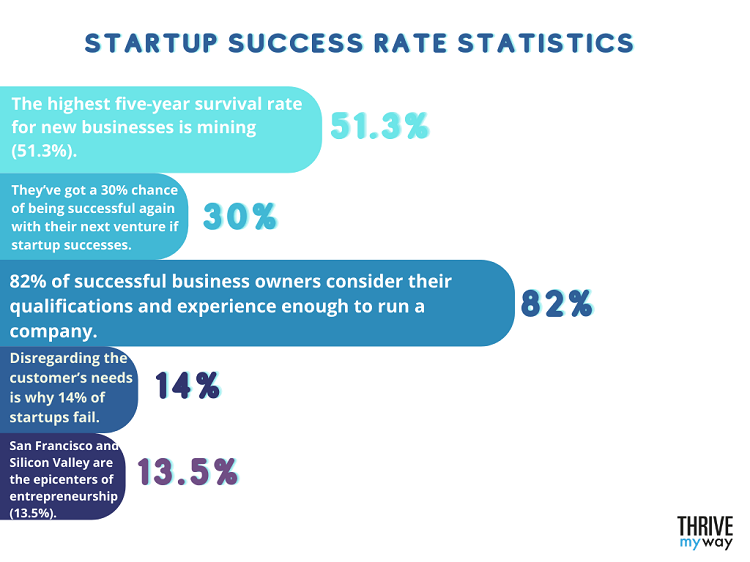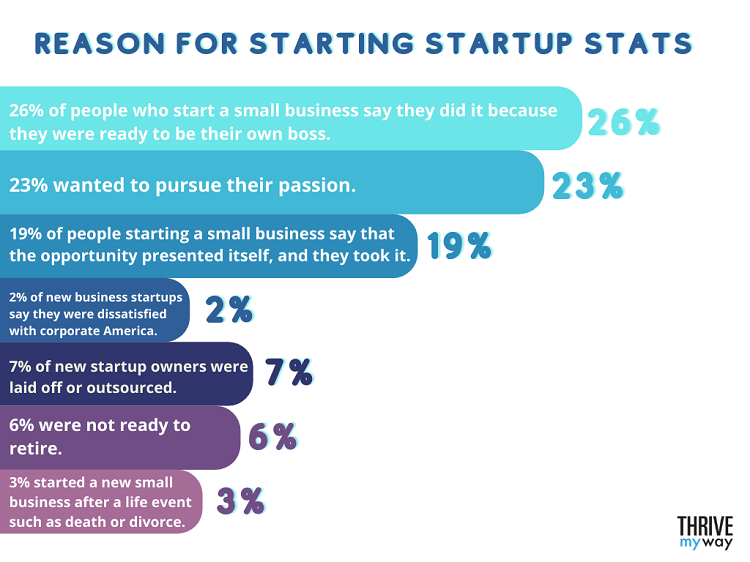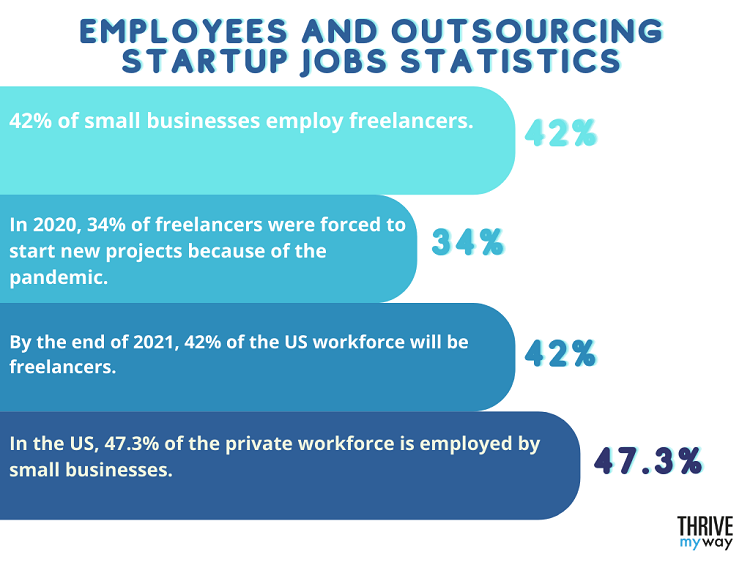Thousands of ambitious entrepreneurs start a new business every year filled with hope and excitement.
But, sadly, statistics for the startup failure rate show that four years down the road, more than half of them will be gone.
Let’s just put that statistic aside for a few minutes while we share more uplifting and encouraging statistics about startup businesses.
There are businesses that make it past the critical four-year period, and the following facts and figures will show you how many make it and what you can do to increase your chance of success.
Table of Contents
ToggleGeneral Startup Statistics 2024
- 69% of entrepreneurs in the US start their businesses at home.
- Just over one-third of startups fail because of a lack of profitability or capital.
- In 2020, 4.4 million new companies began operating.
- The most successful startups have impact-driven founders.
- Artificial intelligence startup funding grew to $8.2 billion in 2020.
- From 2017 to the first half of 2019, the global startup economy created around $3 trillion in value.
- In 2020, Silicon Valley ranked number one in the Top 30 Global Startup Ecosystems and Runners-up list.
- 40% of startups manage to become profitable.
- The greatest challenge for a startup is competition (19%).
- According to a report from the National Association of Small Business, 35% of small businesses are LLCs, followed by S-corporations (33%), corporations (19%), sole proprietorships (12%), and partnerships (2%).
Surprising Statistics About Startups
- Unicorn companies are startups valued at $1 billion or more, and the most valuable one in the world is ANT Financial, with a value of more than $150 billion.
- Around 50% of Unicorn companies are located in the United States.
- Only two in five startups are profitable, and one in three startups will either break even or continue to lose money.
- It takes just six days to start a business in the US.
- A mentored startup will grow 3.5 times faster and raise seven times more money.
Startup Statistics by Country Ranking
- The US is the leading country by the number of startups (63,703).
- Second place on the list is India, with only 8,301 startups.
- The third spot goes to the UK with 5,377 startups.
- China and the US account for most of the highest-value startups.
- Chile ranks as the top entrepreneurial country worldwide.
- New Zealand, Hong Kong, and China are the best places to open a business in 2021.
- Latin American entrepreneurs are considered the most fearless.
The State of Startups Statistics

- 45% of European startups said that they have easy access to financing.
- 32% of European startups said they had difficulty getting access to funding.
- 66% of European startups said that their primary funding source is self-financing, whereas 9% were funded through business angels and 7% from venture capital firms.
- 42% of startups in the UK, Canada, and the US had venture capital as their primary funding source.
- In 2020, Black and Latinx women founders raised $3.1 billion for their venture-backed startups.
- A growing number of Black and Latinx women founders have raised more than $1 million in the median seed funding round.
Startup Success Rate Statistics

- The highest five-year survival rate for new businesses is mining (51.3%).
- If a startup founder has previously achieved business success, they’ve got a 30% chance of being successful again with their next venture.
- 82% of successful business owners consider their qualifications and experience enough to run a company.
- Disregarding the customer’s needs is why 14% of startups fail.
- The main challenge for any new startup is generating new business.
- In 2017, US healthcare startups were the strongest and brought in $36.3 billion in revenue together with Inc. 5000 companies.
- San Francisco and Silicon Valley are the epicenters of entrepreneurship, home to 13.5% of all global startups.
Startup Failure Rate Statistics
- Around 90% of startups fail.
- 10% of startups fail within the first year of operation.
- Startup failure rates appear to be very similar, regardless of the industry.
- 70% of startups fail during years two through five.
- 42% of startups failed because they misread target market demand.
- 29% of startups failed because they ran out of funding and personal money.
- In 2018, 82% of businesses that went under did so because of problems with cash flow.
- The top causes of small business failure are no market need (42%), running out of cash (29%), not having the right founding team (23%), getting outcompeted (19%), pricing/cost issues (18%), and user-unfriendly product (17%).
Effect of the COVID-19 Pandemic on Startups
- 77% of startup founders said they faced potential failure in 2020 due to the global pandemic.
- Since the beginning of the pandemic, typical startups have laid off an average of 33% of their staff.
- The pandemic has meant four out of ten startups are in the red zone, which means they’ve got three months or less of the capital runway.
- Since the start of the pandemic, 72% of startups have experienced a decrease in revenue.
- On average, the decline was 32%.
- More than 40% of companies experienced a revenue decline of 40% or more.
- Expense cutbacks have been made by an average of 22% of startups due to the pandemic.
- Regarding OECD countries (Organisation for Economic Co-operation and Development), the hardest hit was Portugal. Between March and April 2020, Portugal’s business formation experienced a 70% decline.
- Turkey (58%), France (54%), and Hungary (47%) have also been severely impacted.
- Fintech deals fell to around 30% in the second quarter of 2020, compared to the year’s first quarter.
- In the second quarter of 2020, Asian and European fintech startups observed the lowest deal count since the fourth quarter of 2016.
Post-Pandemic Outlook
- 31.2% of entrepreneurs say they are optimistic about startups, so much so that they were planning to start one in 2021.
- 32.9% of respondents believe that now is an excellent time to start a business.
- In February 2021, 63.9% of entrepreneurs were more likely or very likely to start a new business now than in the previous three months.
- 7.7% of entrepreneurs said they were less likely to start a business now than three months ago.
- 37.3% said that the pandemic had increased their interest in controlling their destiny through company ownership.
- 28.8% said that the pandemic has made them lean towards pandemic-resistant businesses.
- 72% of startup founders say they feel optimistic that the recruitment pace will increase in 2021.
- The startup jobs most likely to benefit from the predicted spike in hiring are logistics, eCommerce, deep-tech, and digital media sectors.
- Analysts are predicting that the US will experience a 5% economic growth rate.
- In the post-pandemic years, investor focus will likely shift to more traditional sectors such as banking, airlines, hotels, and energy.
Startups Financial Stats, Facts, and Figures
Startup Funding Statistics
- When you make a funding pitch, how much detail is in your data and the value of your pitch deck are the two strongest factors that can affect the amount of funding you receive.
- Less than 1% of startups evolve into unicorn startups such as Airbnb, Uber, Stripe, Docker, and Slack.
- In 2017, venture capital funding reached a decade-high level of $155 billion.
- 33% of startup capital for employer firms is less than $10,000.
- 1 in 3 small businesses starts with less than $5,000.
- Three-quarters of new firms use business loans, credit cards, and lines of credit for financing.
- 65% of startups admit to not being confident they’ve got enough money to start their business.
- 93% said they calculated they might run short of money in less than 18 months.
- The most popular small business financing methods in 2018 were: personal funds (77%), bank loans (34%), borrowing from family and friends (16%), donations from family and friends (9%), online lenders (4%), angel investors (3%), venture capital (3%), and crowdfunding (2%).
Startup Costs Statistics
- One of the highest startup costs across the US is payroll, and it averages around $300,500 for five employees.
- 77% of startups use personal funds to cover startup costs.
- Prominent unicorn startups, such as Uber and Airbnb, have taken one billion dollars or more in debt to becoming more successful.
- The cost of equipment for a startup ranges from $10,000 to $125,000.
- The most expensive startups to launch are restaurants, medical offices, and manufacturing, all of which require more than $100,000 to get started.
- The cost of health insurance is one of the biggest challenges a startup has to overcome.
- Startups with the lowest costs are accounting, construction, landscaping, and online retail, with under $5,000 in startup costs.
- 73% of startups want to invest more in their social media, and 57% plan to increase investment in email marketing.
Startup Founder Demographics and Diversity Statistics
Reason for starting

- 26% of people who start a small business say they did it because they were ready to be their own boss.
- 23% wanted to pursue their passion.
- 19% of people starting a small business say that the opportunity presented itself, and they took it.
- 2% of new business startups say they were dissatisfied with corporate America.
- 7% of new startup owners were laid off or outsourced.
- 6% were not ready to retire.
- 3% started a new small business after a life event such as death or divorce.
Gender
- The ratio of men to women entrepreneurs in 2019 was 10:7.
- In 2019, 73% of small business owners identified as male, while 25% identified as female.
Education
- 33% of people starting a small business have a High School/GED.
- 18% have an Associate’s Degree.
- 29% have a Bachelor’s Degree.
- 16% have a Master’s Degree.
- 4% of people starting a small business have a Doctorate.
Age
- A study in 2018 found that a 60-year-old is three times more likely to build a successful startup than a 30-year-old.
- When it comes to age, the largest percentage of small business owners are in the 50-59 age bracket, while the smallest percentage is over 70 (40%).
- 25% of people starting a small business are 40-49 years old.
- 18% of people are 60-69 years old.
- 14% of people are 30-39 years old.
- 4% of people starting a small business are 18-29 years old.
Ethnicity
- 71% of new startups are owned by White/Caucasians.
- 11% are Asian/Pacific Islanders.
- 7% are Black/African Americans.
- 6% are Hispanic/Latinos.
Small Business Statistics for Startup Teams

- 99% of US businesses are considered small, which means they have less than 500 employees.
- On average, finding the right employee for a startup takes six months.
- A startup team will be weak if it has high levels of previous experience but average to low collective vision and passion levels.
- A startup owner can spend 40% of their working day doing tasks that generate no income, such as payroll, hiring, and HR tasks.
- Companies with 11-50 employees are more likely to fail than companies with more than 50 employees.
- A startup’s chance of success increases when there are two founders, three times the customer growth, and 30% more investment.
- More than half of small businesses have a Chief Financial Officer.
Employees and Outsourcing Startup Jobs Statistics

- In 2020, just over one-third of the US workforce was made up of freelancers.
- 42% of small businesses employ freelancers.
- In 2020, 34% of freelancers were forced to start new projects because of the pandemic.
- By the end of 2021, 42% of the US workforce will be freelancers.
- In the US, 47.3% of the private workforce is employed by small businesses.
- Most small business employees will stick around for around four years.
- In 2020, China had more patent applications than anywhere else in the world.
- In 1990 there were 997,501 annual patent applications globally, and two decades later, the annual number had increased to 3,224,000.
- Intellectual property services made a contribution of $115.3 billion to the US trade deficit in 2020.
- The amount spent on intellectual property is more than any other US business service.
Startups Industry Specific Statistics
- The industries with the maximum number of small business startups in 2018 were business services (11%), food-restaurant (11%), health/beauty/fitness (10%), general retail (7%), and home services (6%).
- The five most profitable small business industries by net profit margin (NPM) are accounting/tax preparation,/bookkeeping/payroll services (18.4% NPM), lessors of real estate (17.9% NPM), legal services (17.4% NPM), management of companies and enterprises (16% NPM), and activities related to real estate (14.9% NPM).
- The top five least profitable industries in the US by Net Profit Margin (NPM) are oil and gas extraction (6.9% NPM), software publishers (5.1% NPM), beverage manufacturing (3.7% NPM), semiconductor and other electronic component manufacturing (0.3% NPM), and forging and stamping (0.4% NPM).
Statistics for FinTech Startups
- 7.1% of startups in the world operate in the fintech industry.
- According to research, successful fintech startups rely on data-driven iteration and continuous user testing rather than new technology alone.
- Global venture capital fintech investment reached $30.8 billion in 2018, which was an increase of $1.8 billion from 2011.
- In 2018, the average investment in cryptocurrency and blockchain increased by more than $1 million.
- The fintech market includes 39 venture capital-backed unicorns worth a total of $147.37 billion.
- The largest challenge for fintech startups is the cost of customer acquisition.
Construction Startup Statistics
- The failure rate in construction is the second highest at 53%.in 2017, construction startups in North America brought in $581.6 million in funding compared to $182.7 million in 2013.
- Last year, investors made contributions to 86 construction startup deals.
- The construction industry is one of the least digitized.
- The chances of a new construction startup lasting more than five years are 36.4%.
- AI technology is all set to boost construction industry startup profits by 71%.
- The fastest-growing construction sector is residential housing construction.
Technology Startup Statistics
- The average age for tech founders is 39.
- The US has the most prominent tech market globally, and its value in 2019 was $1.6 trillion.
- On average, 20 technology companies are founded per year in the US, reaching $100 million in revenues.
- As of 2018, the tech startup industry has the highest startup company failure rate of 64%.
- On average, 20 technology companies are founded per year, reaching $100 million in revenues.
- Between 2007 and 2016, tech-based wage growth was 20% compared to just 3% for the average US wage growth.
- Between 2007 and 2016, electronics and computer manufacturing startups have risen by 78%.
- The robotics industry has grown by 1,400% over the last five years.
- Artificial intelligence funding grew to $8.2 billion in 2020.
Real Estate Startup Statistics
- In 2019, real estate startups raised $1.9 billion.
- Property technology (known as prop-tech) startups are rising with 255 starting in 2014.
- Over $13 billion was invested in prop-tech companies worldwide in 2017.
- Around 31% of commercial real estate investors plan to invest in prop-tech companies.
- 26% of commercial real estate investors plan on partnering with prop-tech companies.
- Residential real estate startups that use artificial intelligence tools bring in the most investments.
The Future of Startup Statistics
- 60% of entrepreneurs agree that AI is currently the most promising innovation technology and will remain so for the next decade.
- The sharing economy market is expected to reach a total sales revenue of $335 billion by 2025.
- By 2024, the entire green technology and sustainability market size is expected to reach $28.9 billion.
- The next few years will see a proliferation of entrepreneurs fresh out of college.
- The top five fastest-growing startup industries by volume of investment are healthcare (41.2%), transportation (25.5%), financial services (24.6%), artificial intelligence (16%), and eCommerce (13.5%.
- An increasing number of startup founders are leaving the Silicon Valley “bubble” and heading to the East coast.
- Recognizing that personalized marketing has a significant role to play in the success of your startup is important.
- Startup subscription boxes related to apparel, lifestyle, food, and beauty products are projected to continue to be popular.
- More and more startups will choose to collaborate and become open to partnerships.
- When asked about long-term goals, 50% of company leaders said the acquisition was the most realistic scenario.
- The total value of the biotech industry is around $295 billion, but further growth is expected in 2021 due to the development of DNA analysis technologies.
You might be interested to check those related posts as well:
- 30+ Interesting Coffee Statistics for Startups 2024
- 122 Essential Small Business Stats 2024 [Facts and Trends]
- The Best B2B Services Review Platforms 2024 [for Business]
FAQs
What industry has the highest failure rate?
Construction companies represent the largest percentage of failed startups globally (20.2%) and the second-largest percentage of failed startups in the United States (13.7%).
What percentage of startups become unicorns?
A business only has a 0.00006% chance of becoming a unicorn. Plus, it takes an average of seven years for nascent startups to grow into unicorns.
How long does the average startup last?
The average startup lasts three to five years before it goes under or another company acquires it for its valuable assets, including intellectual property.
What percentage of startups are IPO?
Around 90% of startup companies funded will not make it to the initial public offering (IPO).
Conclusion
The pandemic has led to some setbacks, but entrepreneurship and its spirit are still alive and very much present worldwide. The world economy is starting to open up, and more people are becoming optimistic about taking the plunge and hoping they’ll be able to make a success of their startup.
The startup statistics we’ve shared should fuel your enthusiasm rather than put you off, and help you adjust to the trends, but at the same time be efficient and sustainable.
We scoured the internet for the most appropriate, helpful, and inspiring startup statistics and would like to share the credit with the following:



